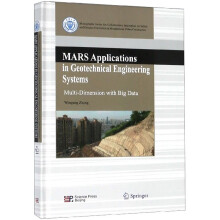MARS Applications in Geotechnical Engineering Sy

目 录内容简介
1 Introduction
1.1 Background
1.2 Objectives and Scope of This Book
1.3 Outline of This Book
References
2 A Review of Surrogate Models
2.1 Several Commonly Adopted Approaches
2.1.1 Response Surface Methods
2.1.2 Regression Analysis
2.1.3 Artificial Neural Networks
2.2 MARS Methodology
2.2.1 A Brief Introduction of MARS
2.2.2 MARS Algorithm
2.2.3 MARS Applications
2.3 Summary
References
3 Simple MARS Modeling Examples
3.1 Simple Function Approximation
3.2 Two-Dimensional Approximation
3.3 Function Approximation with Noise
3.4 Summary
Reference
4 MARS Use in Prediction of Collapse Potential
for Compacted Softs
4.1 Background
4.2 The Database
4.3 The Developed MARS Models and Modeling Results
4.4 Model Interpretability
4.5 Parameter Relative Importance
4.6 Summary
References
5 MARS Use in Prediction of Diaphragm Wall Deflections
in Soft Clays
5.1 Backgmund
5.2 The Database
5.3 The Developed MARS Models and Modeling Results
5.4 Model Interpretability
5.5 Parameter Relative Importance
5.6 Assessment of the Proposed MARS Model
5.7 Summary
References
6 MARS Use for Inverse Analysis of Soil and Wall Properties
in Braced Excavation
6.1 Background
6.2 The Databases
6.3 The Developed MARS Eso/Cu Model and Parametric
Sensitivity Analysis
6.4 Excavation History Validations on Eso/Cu Model
6.5 The Developed MARS In(S) Model and Parametric
Sensitivity Analysis
6.6 Excavation History Validations on In(S) Model
6.7 Summary
References
7 MARS Use for Estimations of Lateral Wall Deflection Profiles
7.1 Background
7.2 The Databases
7.3 The Developed MARS Model and Modeling Results
7.4 Parametric Sensitivity Analysis
7.5 Excavation Case History Validations
7.6 Summary
References
8 MARS Use for Determination of EPB Tunnel-Related
Maximum Surface Settlement
8.1 Background
8.2 Ground Conditions
8.3 Data Sets and the Influential Parameters
8.3.1 Tunnel Geometry
8.3.2 Geological Conditions
8.3.3 EPB Operation Factors
8.4 The Developed MARS Model and Modeling Results
8.5 Parametric Sensitivity Analyses
8.6 Summary
References
9 MARS Use in HP-Pile Drivability Assessment
9.1 Background
9.2 The Database and Performance Measures
9.3 The Developed MARS Models and Modeling Results
9.3.1 Pile Category Ql
9.3.2 Pile Categories Q2-Q5
9.4 Combined Data set Q1-Q5
9.4.1 Model Interpretability
9.4.2 Parameter Relative Importance
9.5 Summary
References
10 MARS Use in Estimation of Liquefaction-Induced Lateral
Spreading
10.1 Background
10.2 The Database
10.3 The Developed MARS Model
10.4 Parametric Sensitivity Analysis and Model Interpretability..
10.5 Design Charts
10.6 Discussions and Summary
References
11 MARS Use in Assessment of Soil Liquefaction Based
on Capacity Energy Concept
11.1 Background
11.2 The Database
11.3 MARS Modeling Results
11.4 Parameter Relative Importance
11.5 The Developed MARS Model
11.6 Parametric Sensitivity Analysis
11.7 Validation from Case Histories
11.8 Performance Comparisons
11.9 Summary
References
12 MARS_LR Use in Assessment of Soil Liquefaction
12.1 Background
12.2 Modeling Accuracy
12.3 The Databases
12.3.1 Database 1
12.3.2 Database 2
12.3.3 Database 3
12.4 The Developed MARS_LR Models and Modeling Results...
12.4.1 MARS_LR Model 1
12.4.2 MARS_LR Model 2
12.4.3 MARS_LR Model 3
12.5 Summary
References
13 MARS Use in Evaluating Entry-Type Excavation Stability
13.1 Background
13.2 Critical Span Graph and the Database
13.3 The Developed MARS_LR Model and Modeling Results
13.4 Model Interpretability
13.5 Summary
References
14 Conclusions and Recom
……
1.1 Background
1.2 Objectives and Scope of This Book
1.3 Outline of This Book
References
2 A Review of Surrogate Models
2.1 Several Commonly Adopted Approaches
2.1.1 Response Surface Methods
2.1.2 Regression Analysis
2.1.3 Artificial Neural Networks
2.2 MARS Methodology
2.2.1 A Brief Introduction of MARS
2.2.2 MARS Algorithm
2.2.3 MARS Applications
2.3 Summary
References
3 Simple MARS Modeling Examples
3.1 Simple Function Approximation
3.2 Two-Dimensional Approximation
3.3 Function Approximation with Noise
3.4 Summary
Reference
4 MARS Use in Prediction of Collapse Potential
for Compacted Softs
4.1 Background
4.2 The Database
4.3 The Developed MARS Models and Modeling Results
4.4 Model Interpretability
4.5 Parameter Relative Importance
4.6 Summary
References
5 MARS Use in Prediction of Diaphragm Wall Deflections
in Soft Clays
5.1 Backgmund
5.2 The Database
5.3 The Developed MARS Models and Modeling Results
5.4 Model Interpretability
5.5 Parameter Relative Importance
5.6 Assessment of the Proposed MARS Model
5.7 Summary
References
6 MARS Use for Inverse Analysis of Soil and Wall Properties
in Braced Excavation
6.1 Background
6.2 The Databases
6.3 The Developed MARS Eso/Cu Model and Parametric
Sensitivity Analysis
6.4 Excavation History Validations on Eso/Cu Model
6.5 The Developed MARS In(S) Model and Parametric
Sensitivity Analysis
6.6 Excavation History Validations on In(S) Model
6.7 Summary
References
7 MARS Use for Estimations of Lateral Wall Deflection Profiles
7.1 Background
7.2 The Databases
7.3 The Developed MARS Model and Modeling Results
7.4 Parametric Sensitivity Analysis
7.5 Excavation Case History Validations
7.6 Summary
References
8 MARS Use for Determination of EPB Tunnel-Related
Maximum Surface Settlement
8.1 Background
8.2 Ground Conditions
8.3 Data Sets and the Influential Parameters
8.3.1 Tunnel Geometry
8.3.2 Geological Conditions
8.3.3 EPB Operation Factors
8.4 The Developed MARS Model and Modeling Results
8.5 Parametric Sensitivity Analyses
8.6 Summary
References
9 MARS Use in HP-Pile Drivability Assessment
9.1 Background
9.2 The Database and Performance Measures
9.3 The Developed MARS Models and Modeling Results
9.3.1 Pile Category Ql
9.3.2 Pile Categories Q2-Q5
9.4 Combined Data set Q1-Q5
9.4.1 Model Interpretability
9.4.2 Parameter Relative Importance
9.5 Summary
References
10 MARS Use in Estimation of Liquefaction-Induced Lateral
Spreading
10.1 Background
10.2 The Database
10.3 The Developed MARS Model
10.4 Parametric Sensitivity Analysis and Model Interpretability..
10.5 Design Charts
10.6 Discussions and Summary
References
11 MARS Use in Assessment of Soil Liquefaction Based
on Capacity Energy Concept
11.1 Background
11.2 The Database
11.3 MARS Modeling Results
11.4 Parameter Relative Importance
11.5 The Developed MARS Model
11.6 Parametric Sensitivity Analysis
11.7 Validation from Case Histories
11.8 Performance Comparisons
11.9 Summary
References
12 MARS_LR Use in Assessment of Soil Liquefaction
12.1 Background
12.2 Modeling Accuracy
12.3 The Databases
12.3.1 Database 1
12.3.2 Database 2
12.3.3 Database 3
12.4 The Developed MARS_LR Models and Modeling Results...
12.4.1 MARS_LR Model 1
12.4.2 MARS_LR Model 2
12.4.3 MARS_LR Model 3
12.5 Summary
References
13 MARS Use in Evaluating Entry-Type Excavation Stability
13.1 Background
13.2 Critical Span Graph and the Database
13.3 The Developed MARS_LR Model and Modeling Results
13.4 Model Interpretability
13.5 Summary
References
14 Conclusions and Recom
……
目 录内容简介
许多岩土工程问题依靠经验方法以方程或设计图表的形式表达,以确定系统对输入变量的响应。《MARS Applications in Geotechnical Engineering Sy》探索了一种相当简单的非参数回归算法,称为多元自适应回归样条法(MARS),它能够逼近输入和输出之间的关系,并在数学上表示这种关系。主要优点是它能够产生简单、易于解释的模型,它能够估计输入变量的贡献,以及它的计算效率。《MARS Applications in Geotechnical Engineering Sy》首先介绍了MARS算法。然后介绍了多变量大数据集在岩土工程中的应用,探讨了该方法的泛化能力和精度。
比价列表
公众号、微信群
 缺书网
缺书网微信公众号
 扫码进群
扫码进群实时获取购书优惠





